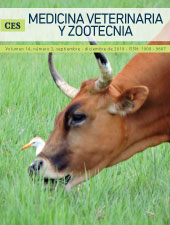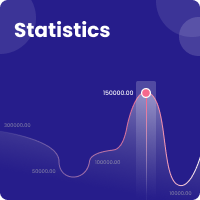Nutritional value of quinoa forage silage (Chenopodium quinoa willd) with the addition of efficient microorganisms
DOI:
https://doi.org/10.21615/cesmvz.14.3.2Abstract
The cultivation of grasses and legumes with high nutritional value to meet the nutritional requirements of animals, is an alternative for reducing costs in animal production. The objective of the study was to characterize the nutritional quality of the quinoa silage (Chenopodium quinoa willd) yellow variety of marangani with the addition of efficient microorganisms in relation to the age of quinoa and the different periods of silage fermentation. The quinoa plant material (leaves and stems) was collected, three cutting ages were evaluated: 60, 90 and 120 days and four periods of silage fermentation: seven, fourteen, twenty one and thirty days. Four treatments were performed: treatment 1 (T1) refers to the control without applying any type of MS, treatments T2, T3 and T4 were applied MS at the dose indicated on the label as silage additive, each treatment was performed in triplicate . The plant material was dehydrated for a period of 5 hours and subsequently the quinoa foliage microsyls were made. The nutritional value (dry matter, neutral detergent fiber, acid detergent fiber, ash and crude protein) was determined to the foliage and quinoa microsilos. A completely randomized design (DCA) with an arrangement of time-divided plots was used, an analysis of variance was made using the Mixed Linear Model and a separation of means by the Duncan method and a correlation of Pearson variables. For the humidity variable, a range of 81,3 – 87,7% was found for T1 and a range of values of 57,3 – 90,3% for the other treatments. The ashes were maintained in values similar to the quinoa foliage in relation to the different ages of regrowth, the highest percentage of ashes was obtained at 21 days of silage fermentation with a value of 20,3% for T3 with the silage of Quinoa foliage 90 days of regrowth; while the crude protein content decreased slightly in relation to T1 in the 120-day regrowth age, presenting significant variations between treatments with values of 11,3-17,3%. A directly positive proportion directly proportional (P≤0,01) was presented between the FDA and FDN averages (r=0.975) for all the treatments evaluated. The quinoa plant would allow multipurpose use of the crop, generating grain for human consumption and foliage for animal consumption.Downloads
References
Arbós, X. y Giner, S. (1998). La gobernabilidad ciudadanía y democracia en la encrucijada mundial. Madrid, España. Siglo veintiuno
Acemoglu & Robinson. (2005). Los origines coloniales del desarrollo comparativo: investigación empírica. Estados Unidos: Revista de Economía Institucional, vol. No. 13 segundo semestre 2015: Harvard.
Bardhan, P. (1997). Corruption and development: A review of issues. United States of America: Journal of Economy Literature.
Departamento de Administración y Estadística Nacional (2018) Estadísticas por tema. 10/03/2018. De: https://www.dane.gov.co/index.php/estadisticas-por-tema.
Dornbusch, R., Fischer, S., Starts, R. (2009) Macroeconomía, México, D.F. Mc Graw Hill.
Del Castillo, A. (2003) Medición de corrupción: un indicador de la rendición de cuentas, México, D.F. Consejo de la judicatura federal.
Harrison, L. E. & Huttington, S. (1997) Culture Matters, New York, USA: Basic Books.
Huntington, S. (1968). Political order in changing societies. New Haven, CT: Yale University Press.
Gamarra, J. R. (2006). Pobreza, corrupción y participación política. Cartagena de indias, Colombia: Banco de la República, estudios regionales.
Krauze, E. (3 de diciembre de 1995). Breve historia de la corrupción. 1/03/2018, de Personas e ideas portal de Enrique Krauze. Versión digital disponible en: http://www.enriquekrauze.com.mx/joomla/index.php/opinion/97-art-critica-social/217-breve-historia-corrupcion.html. (junio de 2018)
Leff, Nathaniel (1964). Economic development through bureocratic corruption. American behavioural scientist, 8(2), 8-14.
Latinobarómetro (2018) Banco de datos. 26/01/2018. Versión digital disponible en: https://www.latinobarometro.org/latContents.jsp. (junio de 2018)
Martin & Salman en Harrison, L. E. & Huttington, S. (1997) Culture Matters, New York, USA: Basic Books.
Montoya, M. (2000). La instrumentación política de la corrupción. Estudios Políticos, 0(16), 103-117. Recuperado de http://aprendeenlinea.udea.edu.co/revistas/index.php/estudiospoliticos/article/view/16705
Mauro, P. (1995). Corruption and growth. The quarterly Journal of economics, 110(3), 681-712. Published by: The MIT.
Transparencia internacional (2018) What is corruption? 26/01/2018. Versión digital disponible en: https://www.transparency.org/what-is-corruption. (junio de 2018)
Transparencia internacional (2018) corruption perceptions index 2012. 26/01/2018. Versión digital disponible en: https://www.transparency.org/cpi2012. (junio de 2018)
Transparencia internacional (2018) corruption perceptions index 2013. 26/01/2018. Versión digital disponible en: https://www.transparency.org/cpi2013. (junio de 2018)
Transparencia internacional (2018) corruption perceptions index 2014. 26/01/2018. Versión digital disponible en: https://www.transparency.org/cpi2014. (junio de 2018)
Transparencia internacional (2018) corruption perceptions index 2015. 26/01/2018. Versión digital disponible en: https://www.transparency.org/cpi2015. (junio de 2018)
Downloads
Published
How to Cite
Issue
Section
License
Copyright (c) 2019 CES Medicina Veterinaria y Zootecnia

This work is licensed under a Creative Commons Attribution-NonCommercial-ShareAlike 4.0 International License.
| Article metrics | |
|---|---|
| Abstract views | |
| Galley vies | |
| PDF Views | |
| HTML views | |
| Other views | |



